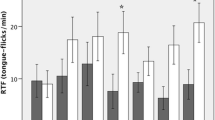Abstract
The common spiny mice Acomys dimidiatus and golden spiny mice Acomys russatus coexist in the extreme warm and dry parts of the Rift Valley in Israel. However, they are temporally segregated in that the former is nocturnal, whereas the latter is diurnal. Daily rhythms of physiological and behavioral variables in A. russatus responded to semiochemical signals released by A. dimidiatus (in the urine and feces). Both species feed upon the same food items but at different times of the 24-hr cycle. The main aim of the present study was to test under field conditions the foraging response of A. russatus to odors of different ages released by A. dimidiatus. Various feeding and behavioral variables were compared in three groups of A. russatus. The results show that fresh semiochemical signals released by A. dimidiatus decrease the feeding efficiency and increase the rate of smelling from a distance in A. russatus. These results support the idea that temporal segregation between the two coexisting species is at least partly through semiochemicals present in the urine and feces.
Similar content being viewed by others
REFERENCES
DEGEN, A. A. 1994. Field metabolic rates of Acomys russatus and Acomys cahirinus, and a comparison with other rodents. Isr. J. Zool. 40:127-134.
DOBLY, A., ROZENFELD, F. M., and HAIM, A. 1999. Lack of neophobic response to traps in a diurnal rodent the golden spiny mouse (Acomys russatus) from an arid environment. Mammalia 63:244-249.
FLUXMAN, S. and HAIM, A. 1993. Daily rhythms of body temperature in Acomys russatus-the response to chemical signals released by Acomys cahirinus. Chronobiol. Int. 10:159-164.
HAIM, A. and FLUXMAN, S. 1996. Daily rhythms of metabolic rates: The role of chemical signals in coexistence of the spiny mice of the genus Acomys. J. Chem. Ecol. 22:223-229.
HAIM, A. and ROZENFELD, F. M. 1993. Temporal segregation in coexisting Acomys species: The role of odour. Physiol. Behav. 54:1159-1161.
HAIM, A. and ROZENFELD, F. M. 1995. Temporal segregation in coexisting Acomys species. The possible role of nest site. J. Arid Environ. 29:505-509.
HAIM, A., YEDIDIA, I., HAIM, D., and ZISAPEL, N. 1994. Photoperiodicity in daily rhythms of body temperature, foods and energy intake of the golden spiny mouse Acomys russatus. Isr. J. Zool. 40:145-150.
HARRISION, D. L. and BATES P. J. 1991. The Mammals of Arabia. Harrison Zoological Museum, Sevenoaks, Kent, UK.
JAFFE, S. 1988. Climate of Israel, pp. 79-94, in Y. Yom-Tov and E. Tchernov (eds.). Zoogeography of Israel: The Distribution and Abundance at Zoogeographical Crossroad. W. Junk Publishers, Dordrecht, The Netherlands.
KERLEY, G. I. H. and ERASMUS, T. 1991. What do mice select for in seeds? Oecologia 86:261-267.
ROZENFELD, F. M., RASMONT, R., and HAIM, A. 1994. Home site scent marking with urine and oral secretion in the golden spiny mouse (Acomys russatus). Isr. J. Zool. 40:161-172.
RUBAL, A., CHOSHNIAK, I., and HAIM, A. 1992. Daily rhythms of metabolic rate and body temperature of two murids from extremely different habitats. Chronobiol. Int. 9:341-349.
SHKOLNIK, A. 1966. Studies in the comparative biology of Israel's two species of spiny mice (genus Acomys). PhD dissertation. Hebrew University of Jerusalem, Jerusalem (English summary).
SHKOLNIK, A. 1971. Diurnal activity in a small desert rodent. Int. J. Biometeorol. 15:115-120.
VAN AARDE, R. and HAIM, A. 1999. The influence of urinary and faecal odours on ovarian function in coexisting Acomys species. Isr. J. Zool. 45:261-265.
Author information
Authors and Affiliations
Rights and permissions
About this article
Cite this article
Dobly, A., Rozenfeld, F.M. & Haim, A. Effect of Congeneric Chemical Signals of Different Ages on Foraging Response and Food Choice in the Field by Golden Spiny Mice (Acomys russatus). J Chem Ecol 27, 1953–1961 (2001). https://doi.org/10.1023/A:1012230601494
Issue Date:
DOI: https://doi.org/10.1023/A:1012230601494




